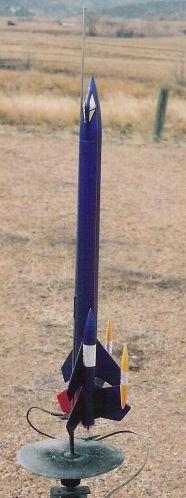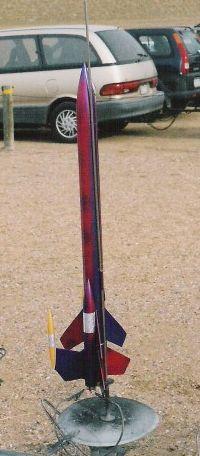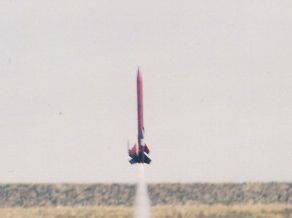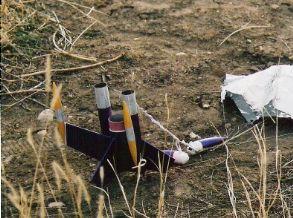| Manufacturer: | Estes  |
 Brief:
Brief:
I changed the booster to a triple 18mm cluster by installing motor mounts into
the two side pods along with a conventional wadding type recovery system in
each side pod capable of utilizing either streamers or 12" parachutes in
each pod. Nose weight added to compensate.
Modifications:
The biggest trick on this one was determining a balance point. I tacked the kit
together in the manner that Estes prescribed and determined the center of
gravity. From there it was a relatively simple matter of adding enough nose
weight to reproduce the CG position in the modified version. 1 1/8 oz. of nose
weight was added in the form of #7 1/2 lead shot and sealed into the nose with
PML expanding foam. The side pods were attached with epoxy, the rest of the kit
was built with Titebond yellow glue. I had read in EMRR about the problems with
the side pods chafing the sustainer air frame on separation. I solved this by
using coffee stir sticks as shims between the booster air frame and the side
pod tubes. This provided about 1/16" of offset. All balsa parts and the
ends of all mount tubes, couplers, and airframe tubes were reinforced by
applying a thin layer of CA to the appropriate surface and sanding after
curing. This should always be done outdoors to disperse the fumes and with
disposable rubber gloves to protect the hands from unwanted bonding. The
sustainer shock cord consisted of two separate pieces of 1/4" shock cord
bound together every few inches by zip ties. This method provides 100 percent
redundancy in separation protection in case one of the elastic cords burns
through. At that point both elastics are replaced.
 Construction:
Construction:
The stock BT-50 x 5" side pod tubes were exchanged for two BT-50 tubes
6.25" long. The plugs for the rear of the pods were discarded and
conventional 18mm Estes mounts were installed in each pod, the rear of the
mount tube flush with the rear of the pod tube, motor hook extending aft and on
the outboard side of each pod tube. The motor mounts were all installed with a
length of 100 lb Kevlar®
shock cord attached to the engine block in the manner of Quest kits. The
Kevlar®
was then attached to elastic shock cord before mounting to the nose cone. 12
inches of 1/8" flat elastic was used in the side pods and a double
24" strand of 1/4" flat elastic in the sustainer.
The overall kit quality is quite typical for the 'Made in China' Estes kits and all of the parts were good quality and fit was as one would expect.
Finishing:
Previous experience with Estes stickers has taught me to avoid them. The tube
spirals were filled with Elmer's Fill 'n' Finish before construction commenced
and more FnF was applied to the fins and fillets after sealing the wood with
CA. Three coats of primer were applied and sanded out after each coat. The
model was finished with Createx Pearl red, Pearl gold, and Pearl purple. All
paint was applied with an airbrush. Hologram tape and striping tape completed
the decoration with the rocket then clear coated with Future floor finish.
Flight:
Only one flight so far, B6-2's in the side pods and a C6-0 to C6-7 combination
in the booster sustainer core. Booster ejection occurred very shortly after
stage separation and both booster and sustainer were successfully recovered
with no damage. A very successful flight with an estimated max altitude of 1500
ft.
Summary:
A very enjoyable experiment, this deals with the Renegade's problems of being
underpowered and prevention of damage to the intricate booster section.


 |
 |
Flights
Sponsored Ads
 |
 |











